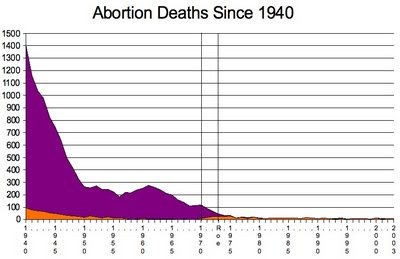During the 1940s, while abortion was still illegal, there was a massive drop in maternal mortality from abortion. The death toll fell from 1,407 in 1940, to 744 in 1945, to 263 in 1950. Most researches attribute this plunge to the development of blood transfusion techniques and the introduction of antibiotics. Learn more here.

Edrica Goode went to a Planned Parenthood in Riverside, California, on January 31, 2007, for a safe, legal second-trimester abortion. She was a little over 14 weeks pregnant. A nurse there inserted laminaria to dilate Edrica's cervx, although Edrica had symptoms of a vaginal infection, at the time. Laminaria are sticks of seaweed that absorb moisture and expand, so they would wick any bacteria or viruses from the vagina into the uterus. Edrica, who had not told her family about the abortion, did not return to the facility to have the laminaria removed and the abortion completed because her mental state had deteriorated overnight. She had became feverish, her mother said. She became mentally "confused and disoriented," not knowing what day it was, and started acting aggressively. She also began vomiting. Planned Parenthood's patient profile for Edrica said that they mailed Edrica two letters telling her that she had to return and have the laminaria removed, but Edrica's mother said that the letters never arrived. She does indicate that Planned Parenthood called, but that Edrica was too sick to take the calls. Edrica's family took her to Riverside County Regoinal Medical Center on February 4. A blood test there revealed the pregnancy to the physicians, but the hospital did not perform a pelvic exam because at the time Edrica was unable to consent to the examination due to confusion and inappropriate speech. Edrica was treated in the medical ward for five days, then transferred to a psychiatric unit, which promptly sent her back to the medical unit to have them check her for possible sepsis. There, her condition continued to deteriorate. After Edrica's boyfriend told her family about the visit to Planned Parenthood, staff at the hospital performed a pelvic examination and discovered the laminaria, along with some gauze. Edrica miscarried that day, and died the next day, Valentine's Day.
Edrica is the third known death among Planned Parenthood patients in California in the last four years. Holly Patterson, 18, died of an infection after an RU-486 abortion in 2003. Diana Lopez, 25, bled to death in 2002 after her cervix was punctured during the procedure.


No comments:
Post a Comment